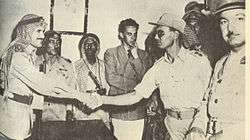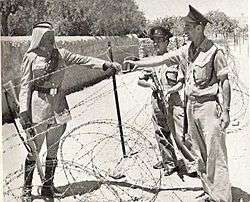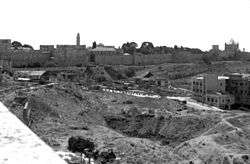City Line (Jerusalem)






City Line (Hebrew: הקו העירוני, Pronounced: HaKav HaIroni) is the name given to a segment of the Green Line that divided the city of Jerusalem from 1948 to 1967. It was 7 km in length, and constituted a temporary boundary line in accordance with Israel's Armistice Agreement with Jordan, which divided the city between East Jerusalem which was part of the Kingdom of Jordan, and West Jerusalem, the capital of the State of Israel. The Old City bordered the City line on the east side, and thus had been part of the "Jordanian Jerusalem". On both sides of the City line fortifications and obstacles were deployed, and different buildings in the city along the line were used as military posts.
History
In November 30, 1948, after the end of the 1948 Arab–Israeli War in Jerusalem, Moshe Dayan, commander of the Israeli Etzioni Brigade, and Abdullah el-Tell, the Jordanian commander, met in an abandoned house in Musrara neighborhood. The two officers drew a map at the scale of 1:20,000 which oulined the boundaries of the ceasefire in Jerusalem. Dayan drew in a green wax pencil line the positions under Israeli control, and el-Tell outlined in a red pencil the positions under the Jordanian line. The area between the two lines, along with the thickness of pencils that drew the two lines on the map, determined a No man's land along the lines. At the time, it seemed to the parties that it is a temporary ceasefire line, and thus they attached no special significance to the inaccuracies errors resulting from the thickness of the pencils, slight deviations in the drawings, and segments of discontinuous lines.
A few months later, in April 1949 during the meetings in Rhodes over the 1949 Armistice Agreements at the end of war, the Dayan and el-Tell map was found to be the only official document indicating the line dividing Jerusalem that was agreed upon both parties. And thus these inaccurate lines that were drawn loosely became a binding international border. The rough map lines had cut across neighborhoods, streets and houses, and were the source of many disputes between the two states. Along the lines, both sides have held positions and fortifications, some in residential and urban public institutions. In the no man's lands landmines were deployed.
The entire Old City, the neighborhoods north of it, and the Mount of Olives, all were in the Jordanian territories. The West of the city, as well as the Mount Scopus enclave in the north-east of the city, was within the Israeli territories. The British Government House (Armon HaNetziv) area was a demilitarized zone controlled by the United Nations, and the house itself was determined to be the headquarters for UN observers. Between the two parts of the city was the Mandelbaum Gate. The crossing was managed by Jordanian and Israeli customs, and served primarily diplomats and UN personnel, as well as Christian pilgrims in Christmas. The crossing also oversaw a bi-weekly convoy to the Israeli enclave on Mount Scopus.
West Jerusalem neighborhoods along the line where living there was considered dangerous, become Slum neighborhoods populated by indigents and were characterized by poverty and neglect. These included the Shmuel HaNavi neighborhood, Mea Shearim, Musrara, Mamilla, and Yemin Moshe.
The city line divided Jerusalem for 19 years, until the Six Day War in June 1967. At noon on June 5, the Jordanians occupied the British Government House from the UN, which marked the beginning of the ground fighting in Jerusalem. The very same day the Israeli Jerusalem Brigade (Brigade 16) captured the British house and the positions to its south. At Dawn on June 6, the second day of the war, the Israeli paratroop forces broke into the city line in the northern part, and then captured the neighborhoods north to the Old City and joined the isolated Mount Scopus. At noon on June 6, the Jerusalem Brigade broke the fences dividing the Abu Tor neighborhood, and the neighborhood conquest completed the encirclement of the Old City. The Old city fell to the IDF in June 7, 1967. Immediately upon the end of the war fences and concrete walls dividing streets and neighborhoods were torn down, the fortifications were dismantled and the mines were removed. The Israeli sovereignty over East Jerusalem was applied, and the two parts of the city were consolidated under the Israeli Jerusalem Municipality that has made great efforts to obscure and hide the scars of the city line.
The City line no longer exists as a political border, but in many ways it continues to exist to this very day and divides the city along ethnic and cultural lines. Nowadays, it is commonly referred as the "Seam line", where the crossing of it is still felt, even in the absence walls and fences.
Outline
The Green line around the Israeli Jerusalem (West Jerusalem) from the south, east and north encircled it in the form of backwards "C". The southern side of the line began in the Arab village of Beit Safafa (today a neighborhood in Jerusalem). The line crossed through the village, while dividing it in two, separating clans, and leaving families on both sides of the border. From there it went on to the east, encircling Kibbutz Ramat Rachel and separating it from the Arab village of Sur Baher, and then it turned north along the eastern border of Arnona and Talpiyot neighborhoods. The location where the building of the Diplomat Hotel (former Ganey Yehuda hotel) stands indicates the place where the line was; the hotel was actually built when its north-east corner is invading by several meters into the demilitarized zone. From Talpiyot it went on to the ridge of the British Government House (Armon HaNetziv), which was a demilitarized zone under UN auspices, and where the headquarters of UN observers who supervised the armistice was located. To the north of the British Government house, the line crossed thorgh Abu Tor neighborhood and divided it into two. Unlike in Safafa, there were no Arabs left on the western side of the line; Their homes were abandoned and later occupied by Jews, who lived very close to their Arab neighbors across the border.
From the Abu Tor ridge the line went down to the Gehenna vally and Sultan's Pool, crossing through the remains of neighborhoods of Bete Shamaa and Jurat al Anab ("Hutzot Hayotzer"), while on his way including in the Israeli territories Mount Zion, which is adjacent to the Old City from the south, but with no road leading to it. It was only in 1964 that Israel and Jordan have jointly built the "Pope's Road" that connected western Jerusalem and Mount Zion, in honor of the visit of Pope Paul VI in the Holy Land. The Sultan's Pool was a no man's land, which bordered the houses of Mishkenot Sha'ananim and Yemin Moshe neighborhoods. From there the line continued north, where it separated the western wall of the Old City (where the Jaffa Gate and the Tower of David are located) from the Mamilla neighborhood, and the Jerusalem Historical City Hall Building. The historic Town Hall, which is located at the IDF square, still carries to this very day, the bullet holes, evidence of the sensitivity of the location.
From the City Hall Building the line trended through the route of the north-west corner of the old city wall, where it separated the Christian Quarter in the north-west of the Old City from the religious institutions that were built by the Christians outside the wall in the "French compound": Saint-Louis Hospital and the building of Notre-Dame de Jérusalem. The line passed close to the northern wall of the Old City and the New Gate at the Damascus Gate area (now called Paratroopers Street), and then leaned back north through Musrara houses, along the route now known as the "Engineering Corps road" and "Bar Lev road". It is in this area where the Street of the Prophets was partitioned, where the central and western parts of the street were in Israeli territories, while the eastern part remained in Jordan. It separated the neighborhoods of Mea Shearim and Beit Yisrael on the Israeli side from the neighborhood of Husseini, the American Colony and Sheikh Jarrah on the Jordanian side. It is also in this area where the Mandelbaum Gate border crossing was agreed upon, which enabled the passage between the two parts of the city and the Israeli connection to its Mount Scopus enclave.
The northern section of the line, in the area of Jerusalem's contemporary neighborhoods of Ma'alot Dafna and Ramat Eshkol, passed between the neighborhoods of Shmuel HaNavi and Sanhedria on the Israeli side, and the Jordanian positions on Ammunition Hill, the Police Academy, and Givat HaMivtar. Adjacent to the line in that section is Sanhedria Cemetery, which was established by the Israelis as an alternative to the cemetery on Mount of Olives, which was controlled by the Jordanians after the 1948 Arab–Israeli War.
See also
| Wikimedia Commons has media related to City Line (Jerusalem). |